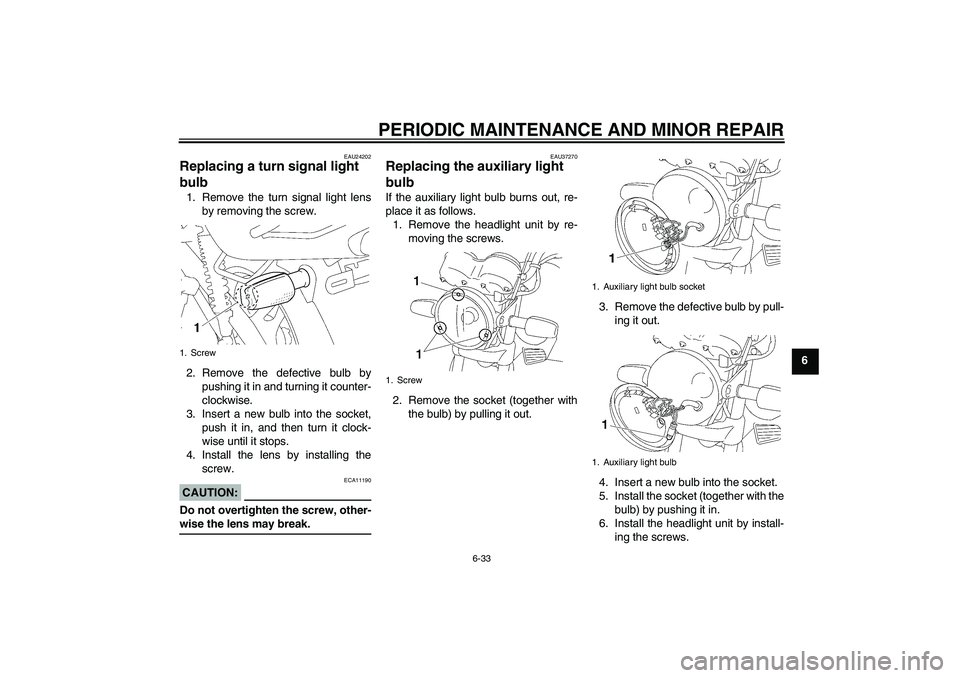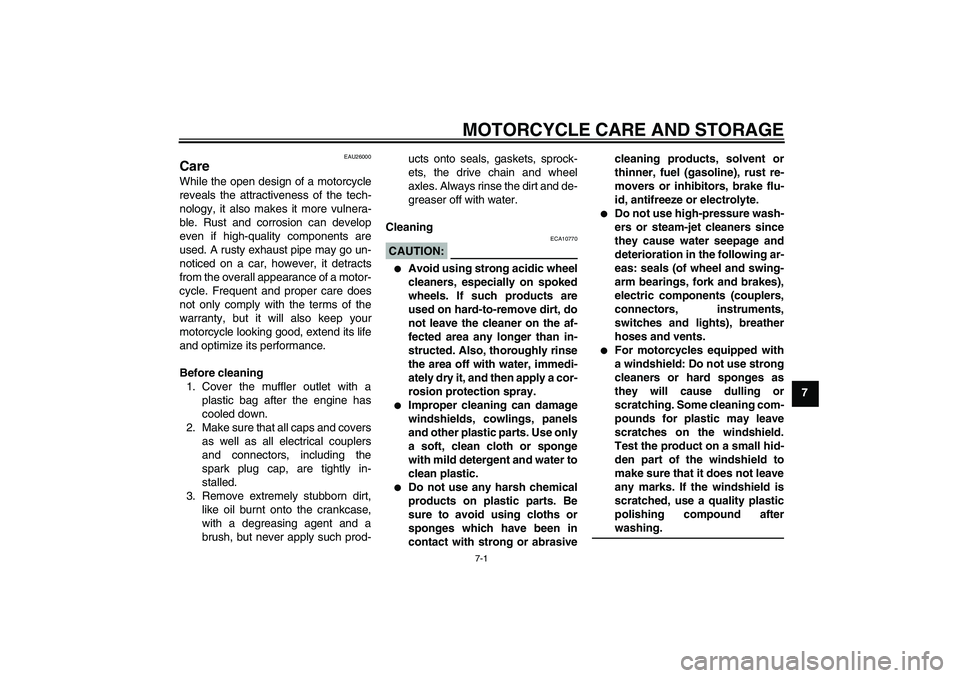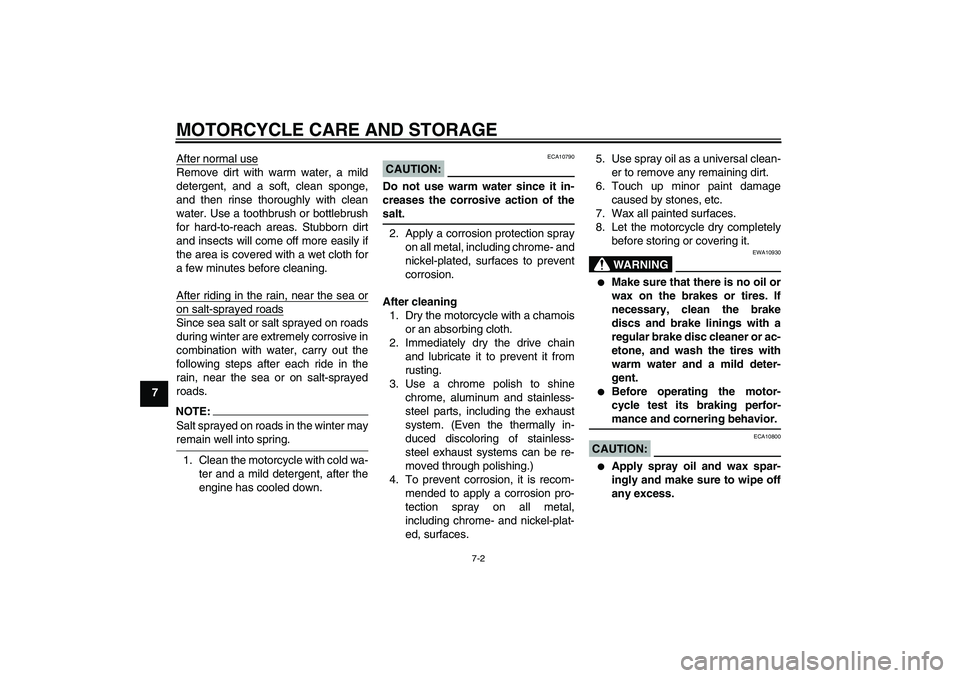Page 65 of 84

PERIODIC MAINTENANCE AND MINOR REPAIR
6-33
6
EAU24202
Replacing a turn signal light
bulb 1. Remove the turn signal light lens
by removing the screw.
2. Remove the defective bulb by
pushing it in and turning it counter-
clockwise.
3. Insert a new bulb into the socket,
push it in, and then turn it clock-
wise until it stops.
4. Install the lens by installing the
screw.CAUTION:
ECA11190
Do not overtighten the screw, other-wise the lens may break.
EAU37270
Replacing the auxiliary light
bulb If the auxiliary light bulb burns out, re-
place it as follows.
1. Remove the headlight unit by re-
moving the screws.
2. Remove the socket (together with
the bulb) by pulling it out.3. Remove the defective bulb by pull-
ing it out.
4. Insert a new bulb into the socket.
5. Install the socket (together with the
bulb) by pushing it in.
6. Install the headlight unit by install-
ing the screws.
1. Screw
1. Screw
1. Auxiliary light bulb socket
1. Auxiliary light bulb
U3D9E0E0.book Page 33 Saturday, December 25, 2004 11:35 AM
Page 66 of 84
PERIODIC MAINTENANCE AND MINOR REPAIR
6-34
6
EAU24360
Front wheel
EAU37041
To remove the front wheel
WARNING
EWA10820
�
It is advisable to have a Yamaha
dealer service the wheel.
�
Securely support the motor-
cycle so that there is no dangerof it falling over.
1. Place the motorcycle on the cen-
terstand.
2. Disconnect the speedometer ca-
ble from the front wheel.3. Remove the rubber caps from the
ends of the wheel axle by pulling
them off.
4. Remove the axle nut and the
washer.5. Pull the wheel axle out, and then
remove the wheel.
CAUTION:
ECA11070
Do not apply the brake after the
wheel has been removed together
with the brake disc, otherwise thebrake pads will be forced shut.
EAU37030
To install the front wheel
1. Install the speedometer gear unit
into the wheel hub so that the pro-
jections mesh with the slots.
1. Speedometer cable
1. Rubber cap
2. Axle nut
3. Washer
1. Rubber cap
2. Wheel axle
3. Washer
U3D9E0E0.book Page 34 Saturday, December 25, 2004 11:35 AM
Page 67 of 84
PERIODIC MAINTENANCE AND MINOR REPAIR
6-35
6 2. Lift the wheel up between the fork
legs.
NOTE:
Make sure that there is enough space
between the brake pads before insert-
ing the brake disc and that the slot in
the speedometer gear unit fits over theretainer on the fork leg.3. Insert the wheel axle, making sure
the washer on the left side is in-
stalled with the beveled side facing
outward, and then install the axle
nut.
4. Take the motorcycle off the center-
stand so that the front wheel is on
the ground.
5. Tighten the axle nut to the speci-
fied torque, and then install both
rubber caps so that they fit over the
washers.6. While applying the front brake,
push down hard on the handlebars
several times to check if the front
fork compresses and rebounds
smoothly.
7. Connect the speedometer cable.1. Speedometer gear unit
1. Speedometer gear unit retainer
Tightening torque:
Axle nut:
59 Nm (5.9 m·kgf, 43 ft·lbf)
U3D9E0E0.book Page 35 Saturday, December 25, 2004 11:35 AM
Page 68 of 84

PERIODIC MAINTENANCE AND MINOR REPAIR
6-36
6
EAU25080
Rear wheel
EAU37180
To remove the rear wheel
WARNING
EWA10820
�
It is advisable to have a Yamaha
dealer service the wheel.
�
Securely support the motor-
cycle so that there is no dangerof it falling over.
1. Loosen the axle nut and the brake
torque rod nut at the brake shoe
plate.
2. Disconnect the brake torque rod
from the brake shoe plate by re-
moving the cotter pin, the nut, and
the bolt.3. Place the motorcycle on the cen-
terstand.
4. Remove the brake pedal free play
adjusting nut, and then disconnect
the brake rod from the brake cam-
shaft lever.5. Loosen the chain puller locknut
and the drive chain slack adjusting
bolt on both ends of the swingarm.
1. Axle nut
2. Brake torque rod
3. Brake torque rod cotter pin
4. Brake torque rod nut and bolt
1. Brake pedal free play adjusting nut
2. Brake rod
3. Brake camshaft lever
1. Wheel axle
2. Chain puller locknut
3. Drive chain slack adjusting bolt
U3D9E0E0.book Page 36 Saturday, December 25, 2004 11:35 AM
Page 69 of 84

PERIODIC MAINTENANCE AND MINOR REPAIR
6-37
6 6. Remove the axle nut, and then pull
the wheel axle out.
7. Push the wheel forward, and then
remove the drive chain from the
rear sprocket.
NOTE:The drive chain does not need to be
disassembled in order to remove andinstall the wheel.
8. Remove the wheel.
EAU37191
To install the rear wheel
1. Install the wheel by inserting the
wheel axle from the left-hand side.
2. Install the drive chain onto the rear
sprocket.
3. Install the axle nut.
4. Install the brake rod onto the brake
camshaft lever, and then install the
brake pedal free play adjusting nut
onto the brake rod.
5. Connect the brake torque rod to
the brake shoe plate by installing
the bolt and nut.
6. Adjust the drive chain slack. (See
page 6-22.)7. Take the motorcycle off the center-
stand so that the rear wheel is on
the ground.
8. Tighten the brake torque rod nut
and axle nut to the specified
torques.
9. Insert a new cotter pin.
10. Adjust the brake pedal free play.
(See page 6-18.)
WARNING
EWA10660
After adjusting the brake pedal free
play, check the operation of thebrake light.
EAU25850
Troubleshooting Although Yamaha motorcycles receive
a thorough inspection before shipment
from the factory, trouble may occur dur-
ing operation. Any problem in the fuel,
compression, or ignition systems, for
example, can cause poor starting and
loss of power.
The following troubleshooting chart
represents a quick and easy procedure
for checking these vital systems your-
self. However, should your motorcycle
require any repair, take it to a Yamaha
dealer, whose skilled technicians have
the necessary tools, experience, and
know-how to service the motorcycle
properly.
Use only genuine Yamaha replace-
ment parts. Imitation parts may look like
Yamaha parts, but they are often inferi-
or, have a shorter service life and can
lead to expensive repair bills.
Tightening torques:
Brake torque rod nut:
19 Nm (1.9 m·kgf, 13 ft·lbf)
Axle nut:
91 Nm (9.1 m·kgf, 66 ft·lbf)
U3D9E0E0.book Page 37 Saturday, December 25, 2004 11:35 AM
Page 70 of 84

PERIODIC MAINTENANCE AND MINOR REPAIR
6-38
6
EAU25962
Troubleshooting chart
WARNING
EWA10840
Keep away open flames and do not smoke while checking or working on the fuel system.
Check the fuel level in
the fuel tank.1. Fuel
There is
enough fuel.
There is
no fuel.
Check the compression.
Supply fuel.
The engine does not start.
Check the compression.
Operate the
electric starter.2. Compression
There is compression.
There is no compression.
Check the ignition.
Have a Yamaha dealer
check the vehicle.
Remove the spark plug
and check the electrodes.3. Ignition
Wet
Dry
Wipe off with a dry cloth and correct the
spark plug gap, or replace the spark plug.
Have a Yamaha dealer check the vehicle.
The engine does not start. Have a
Yamaha dealer check the vehicle.The engine does not start.
Check the battery.Open the throttle halfway and
operate the electric starter.
Operate the
electric starter.4. Battery
The engine turns over
quickly.
The engine turns over
slowly.
The battery is good.Check fluid, recharge,
check connections.
U3D9E0E0.book Page 38 Saturday, December 25, 2004 11:35 AM
Page 71 of 84

MOTORCYCLE CARE AND STORAGE
7-1
7
EAU26000
Care While the open design of a motorcycle
reveals the attractiveness of the tech-
nology, it also makes it more vulnera-
ble. Rust and corrosion can develop
even if high-quality components are
used. A rusty exhaust pipe may go un-
noticed on a car, however, it detracts
from the overall appearance of a motor-
cycle. Frequent and proper care does
not only comply with the terms of the
warranty, but it will also keep your
motorcycle looking good, extend its life
and optimize its performance.
Before cleaning
1. Cover the muffler outlet with a
plastic bag after the engine has
cooled down.
2. Make sure that all caps and covers
as well as all electrical couplers
and connectors, including the
spark plug cap, are tightly in-
stalled.
3. Remove extremely stubborn dirt,
like oil burnt onto the crankcase,
with a degreasing agent and a
brush, but never apply such prod-ucts onto seals, gaskets, sprock-
ets, the drive chain and wheel
axles. Always rinse the dirt and de-
greaser off with water.
Cleaning
CAUTION:
ECA10770
�
Avoid using strong acidic wheel
cleaners, especially on spoked
wheels. If such products are
used on hard-to-remove dirt, do
not leave the cleaner on the af-
fected area any longer than in-
structed. Also, thoroughly rinse
the area off with water, immedi-
ately dry it, and then apply a cor-
rosion protection spray.
�
Improper cleaning can damage
windshields, cowlings, panels
and other plastic parts. Use only
a soft, clean cloth or sponge
with mild detergent and water to
clean plastic.
�
Do not use any harsh chemical
products on plastic parts. Be
sure to avoid using cloths or
sponges which have been in
contact with strong or abrasivecleaning products, solvent or
thinner, fuel (gasoline), rust re-
movers or inhibitors, brake flu-
id, antifreeze or electrolyte.
�
Do not use high-pressure wash-
ers or steam-jet cleaners since
they cause water seepage and
deterioration in the following ar-
eas: seals (of wheel and swing-
arm bearings, fork and brakes),
electric components (couplers,
connectors, instruments,
switches and lights), breather
hoses and vents.
�
For motorcycles equipped with
a windshield: Do not use strong
cleaners or hard sponges as
they will cause dulling or
scratching. Some cleaning com-
pounds for plastic may leave
scratches on the windshield.
Test the product on a small hid-
den part of the windshield to
make sure that it does not leave
any marks. If the windshield is
scratched, use a quality plastic
polishing compound afterwashing.
U3D9E0E0.book Page 1 Saturday, December 25, 2004 11:35 AM
Page 72 of 84

MOTORCYCLE CARE AND STORAGE
7-2
7After normal use
Remove dirt with warm water, a mild
detergent, and a soft, clean sponge,
and then rinse thoroughly with clean
water. Use a toothbrush or bottlebrush
for hard-to-reach areas. Stubborn dirt
and insects will come off more easily if
the area is covered with a wet cloth for
a few minutes before cleaning.
After riding in the rain, near the sea oron salt-sprayed roadsSince sea salt or salt sprayed on roads
during winter are extremely corrosive in
combination with water, carry out the
following steps after each ride in the
rain, near the sea or on salt-sprayed
roads.NOTE:Salt sprayed on roads in the winter mayremain well into spring.
1. Clean the motorcycle with cold wa-
ter and a mild detergent, after the
engine has cooled down.
CAUTION:
ECA10790
Do not use warm water since it in-
creases the corrosive action of thesalt.
2. Apply a corrosion protection spray
on all metal, including chrome- and
nickel-plated, surfaces to prevent
corrosion.
After cleaning
1. Dry the motorcycle with a chamois
or an absorbing cloth.
2. Immediately dry the drive chain
and lubricate it to prevent it from
rusting.
3. Use a chrome polish to shine
chrome, aluminum and stainless-
steel parts, including the exhaust
system. (Even the thermally in-
duced discoloring of stainless-
steel exhaust systems can be re-
moved through polishing.)
4. To prevent corrosion, it is recom-
mended to apply a corrosion pro-
tection spray on all metal,
including chrome- and nickel-plat-
ed, surfaces.5. Use spray oil as a universal clean-
er to remove any remaining dirt.
6. Touch up minor paint damage
caused by stones, etc.
7. Wax all painted surfaces.
8. Let the motorcycle dry completely
before storing or covering it.
WARNING
EWA10930
�
Make sure that there is no oil or
wax on the brakes or tires. If
necessary, clean the brake
discs and brake linings with a
regular brake disc cleaner or ac-
etone, and wash the tires with
warm water and a mild deter-
gent.
�
Before operating the motor-
cycle test its braking perfor-mance and cornering behavior.
CAUTION:
ECA10800
�
Apply spray oil and wax spar-
ingly and make sure to wipe off
any excess.
U3D9E0E0.book Page 2 Saturday, December 25, 2004 11:35 AM